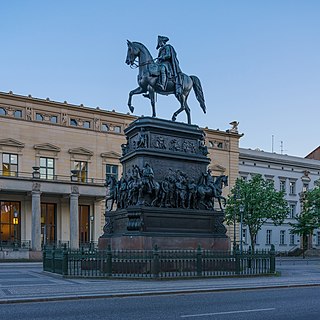
Wilhelm Carl Grimm was a German author and anthropologist. He was the younger brother of Jacob Grimm, of the literary duo the Brothers Grimm.

Hinrich Wilhelm Kopf was a German politician (SPD).

Archduke Leopold Wilhelm of Austria, younger brother of Emperor Ferdinand III, was an Austrian soldier, administrator and patron of the arts.

Prince Sigismund of Prussia was the fourth child and third son of the Crown Prince and Crown Princess of Prussia, later German Emperor Frederick III and Empress Victoria. He was a grandson of William I of Prussia and Victoria, Queen of the United Kingdom.

Prince Waldemar of Prussia was the sixth child and youngest son of the German Crown Prince and Crown Princess, later Emperor Frederick III and Empress Victoria. Prince Waldemar was a grandson of both William I, German Emperor, and Queen Victoria of the United Kingdom.

Allgemeine Deutsche Biographie is one of the most important and comprehensive biographical reference works in the German language.

Maria Anna of Bavaria was a politically active Archduchess of Austria by her marriage to her uncle Archduke Charles II of Austria. She played an important role in the Counter-Reformation in Austria.

Anne of Bohemia and Austria was a Duchess of Luxembourg in her own right and, as a consort, Landgravine of Thuringia and of Saxony.

ArchduchessMaria Elisabeth of Austria, was the governor of the Austrian Netherlands between 1725 and 1741.

Wittelsbach-Hapsburg aristocrat Ernest of Bavaria was Prince-Elector-Archbishop of the Archbishopric of Cologne and, as such, Archchancellor of the Holy Roman Empire and Duke of Westphalia, from 1583 to 1612 as successor of the expelled Archbishop Gebhard Truchsess von Waldburg.

Maria Magdalena of Austria was a governor of Tyrol and daughter of Leopold I, Holy Roman Emperor and his third wife Eleonor Magdalene of the Palatinate-Neuburg. She died unmarried.

Max Ferdinand Bahrfeldt, ennobled as von Bahrfeldt in 1913, was a royal Prussian General of the Infantry, a local historian, and a numismatist of world renown. In the anglophone and francophone world, however, he was also notorious as the alleged perpetrator of atrocities in Charleroi, Belgium, during the German invasion of 1914.

Rochus Wilhelm Traugott Heinrich Ferdinand Freiherr von Liliencron was a Germanist and historian, known for his collection of German Volkslieder, published in five volumes in 1865–1869, and as the editor of the biographical reference work Allgemeine Deutsche Biographie (ADB), published 1875–1912.
The Presidium of the Reichstag was a political office in the German Weimar Republic.

Sigmund von Birken was a German poet of the Baroque. He was born in Wildstein, near Eger, and died in Nuremberg, aged 55.

Robert Pferdmenges was a German banker and CDU politician. He was a member of the Bundestag from 1950 to 1962 and a close friend to Konrad Adenauer.

The equestrian statue of Frederick the Great on Unter den Linden avenue in Berlin's Mitte district commemorates King Frederick II of Prussia. Created from 1839 to 1851 by Christian Daniel Rauch, it is a masterpiece of the Berlin school of sculpture, marking the transition from neoclassicism to realism. The bronze statue shows "The Old Fritz" dressed in military uniform, ermine coat and tricorne hat on horseback above the leading generals, statesmen, artists and scientist of his time. Walled in during World War II, it was disassembled by East Germany in 1950, reassembled in Sanssouci Park in 1963, and returned to its original location in 1980.
Wilhelm August Lampadius was born in Hehlen, Braunschweig-Wolfenbüttel, on 8 August 1772 and died on 13 April 1842 in Freiberg, Kingdom of Saxony. He was a German pharmacist in Göttingen from 1785 until 1791. Also he was an "extraordinary professor" of chemistry and mineralogy in 1794 and an "ordinary professor" in 1795. He taught at the Mining Academy in Freiberg.
Lampadius is best known for inflaming the first coal gas lantern on European ground.
Johann Kolross was a poet, philologist and educator of the German Renaissance and the Protestant Reformation. He studied in Freiburg, and worked as rector of the boys' school in Basel from 1529. He published the Enchiridion, a textbook on orthography, in 1530.
Wilhelm Franz Josef Kosch was an Austrian historian of literature and theatre and lexicographer. The lexicon that he conceived and later revised several times, the Deutsches Literatur-Lexikon is a references in the field of German literature.